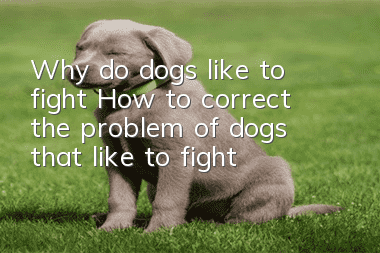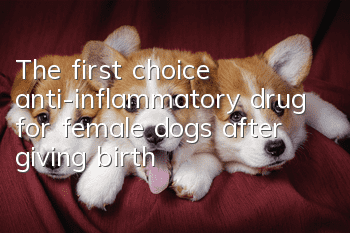Why do dogs like to fight? How to correct the problem of dogs that like to fight?

Dog fights or passive defense attacks
Passive defense is a fear of sexual attack and is one of the most common reasons why dogs attack people or dogs.
Normally, when a dog encounters an object that scares it, it will first choose to retreat. When there is no way to retreat, it will bar its teeth and growl in an attempt to drive away the opponent; if this fails, Or when the object of fear appears too suddenly, the dog will bite and fight in order to protect itself.
In this case, the underlying cause of canine aggression is fear, fear, and thus castration and hormonal treatments are ineffective.
Some powerful owners will use their own control to forcibly prevent and inhibit the dog from attacking when it is afraid. However, this approach treats the symptoms but not the root cause. After the dog stops attacking, it will still be afraid of the target. , when its fear level accumulates to a certain amount, or when a new fear stimulus appears, the dog will relapse and continue to attack.
To solve the fear of sexual assault, we must start from the root cause. Find the root cause of the dog's fear, let the dog adapt to gradual desensitization, or reverse conditioned reflexes to correct it. In addition, enhancing the dog's physique, physical fitness and courage can also help eliminate fear.
Passive defense and aggressive behavior occur because of: Passive defense due to one's own weakness
One of the dogs that has passive defense is because it is very weak, and may have been weak from birth. , was bullied by other strong cubs during the lactation period, and was always squeezed out during lactation. Later, after the lactation period and the dog started eating, because of its weak body and low status, it was always bitten by other dogs when eating, and eating came last, leading to a vicious cycle, in which the body and courage became weaker and weaker.Dogs with weak bodies and low status will also be excluded when eating. Such dogs that have been bullied for a long time will be particularly sensitive to disturbance. After being adopted and brought home by the owner, there may still be many imaginary enemies. When the owner takes him out for a walk one day, if he encounters a similar imaginary enemy, or some of the physical characteristics and behavioral characteristics of the dog are similar to those of the dogs that bullied him before, he will feel fear. When fear reaches a certain limit, they will attack, just like an honest person will fight when cornered.
Training methods for defensive attacks
1. Strengthen exercise and supplement nutrition to make the dog stronger, and the self-confidence will increase and the courage will also increase. 2. At the same time, provide adaptive training to the dog. Take it to a place with many dogs, and let it look at other dogs from a distance while the ownerGive it petting, patting and verbal encouragement, and guide the dog closer by walking and stopping. Give the dog a reward for each step forward. The closer the distance, the greater the reward.When taking your dog out for adaptive training
pay attention to the dog’s gaze, tone of voice, and the speed of approaching or moving away from other dogs. When a dog shows slight signs of fear, stop approaching immediately and do not reward the dog. Because if you reward the dog immediately at this time, it will unconsciously strengthen the dog's fearful behavior just now. If the dog shows aggressive behavior due to fear during training, do not inflict painful stimulation on the dog, and do not do anything that may frighten the dog. This will only be counterproductive. You should stop approaching and wait for an opportunity to take the dog away until the dog thinks In a safe place, lower the difficulty and conduct corrective training later. If the dog is in good condition, you can take another step closer, then fully strengthen it, and then stop when it is good. Repeat several times until the dog can approach other dogs at close range without being afraid or aggressive.Grasp the principles of "step by step", "retreat if you don't advance" and "stop when you're good" during training
The difficulty of each training can be very low at the beginning, and then gradually increase the difficulty. Be sure to ensure success. . Because a failed training often requires multiple correct and effective continuous reinforcements to eliminate the impact of failure.Passive defense and aggressive behavior occur because of: Passive defense due to sudden trauma
Another situation is that the dog originally grew up in a good environment and was mentally and physically healthy. One day, he was suddenly violently attacked by another dog. He was frightened both physically and mentally. From then on, he became extremely wary of other dogs. When another strange dog approaches it, if it sniffs its sensitive parts or makes movements that arouse the dog's vigilance, the dog will be in a defensive state and then attack; or when the strange dog steps into its own "minefield", In order to prevent other dogs from getting too close to themselves, they will also attack. In this case, we need to let the dog understand that the dog approaching it is friendly and not aggressive. If necessary, conditions can be created to force the dog to adapt, and human means can be used to help the dog cross this psychological threshold.Training method
1. Choose an assistance dog of comparable size and gentle personality, and put a muzzle on both your own dog and the corrective dog (you need to conduct muzzle adaptability training in the early stage, and treat the dog's habits Carry out this corrective training after wearing a mouth cage), collar and short leash.
2. Both owners should bring enough reward food and bring the dogs close to each other in a clean environment. During this process, the correctional dog may struggle or escape. The owner should encourage, comfort, stroke and pat the dog while controlling the dog to move forward.
3. After approaching, the owner should control the range of motion of the correction dog to ensure safety, and the assistance dog should stay close to the correction dogBody, touch and smell the whole body appropriately. It can also be done in reverse.
4. After completing all actions, reward the dog. The rewards here are ongoing rewards. After the dog contact is completed, the dog is given a reinforcement reward while the two dogs are not separated, and this continues until the two dogs are taken away respectively and disappear from each other's sight.
5. Repeat the training many times until the dogs (wearing muzzles) can play independently and happily, then the muzzles can be removed and returned to the original conditions for corrective training. After removing the muzzle, both owners should be more vigilant when in contact and not be careless. When the two dogs can play peacefully without a mouth in the cage, the assistance dog can be replaced for training.
- Can dogs eat dates? Feeding some dates in moderation can still have some effects!
- Comprehensive list of medium-sized dog breeds. Do you know all of these dogs?
- Can dogs eat pig lungs? Don’t do it too often!
- Which formula of Bowang dog food should you choose? Which formula is the most nutritious and suitable for dogs?
- How to remove dog tear stains. If you want to avoid tear stains, your behavior is very important!
- Benefits of inbreeding in dogs Can dogs be inbred?
- How to prevent your dog from getting lost? Try these three tricks
- Dog vomits after vaccination. Is this reaction normal?
- How to arrange dog furniture? Three things to note when designing pet living areas
- How to deal with tangled dog hair. Owners must learn these tricks



